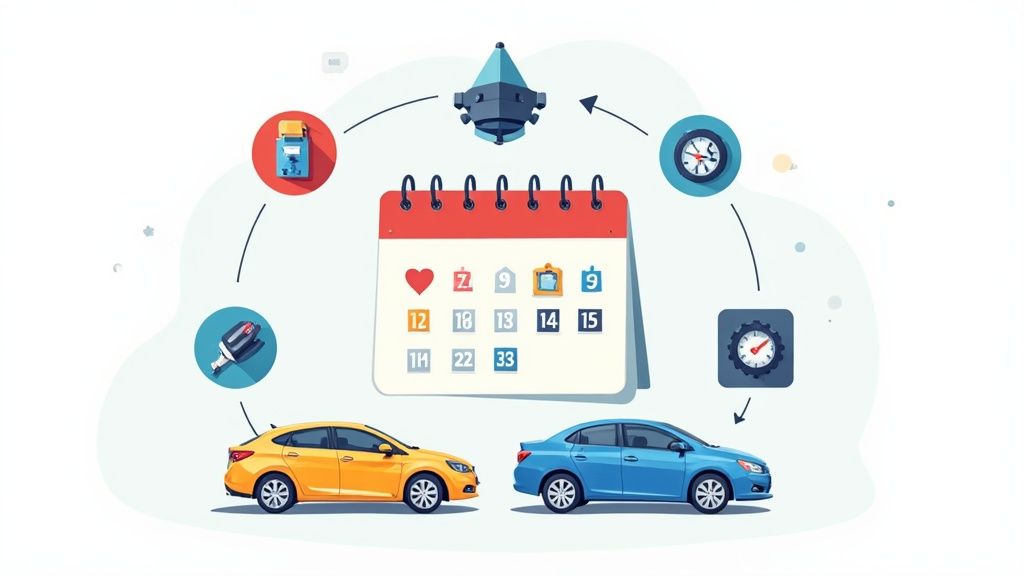
The Ultimate Guide to Vehicle Maintenance Tracker: Keep Your Car Running Smoothly
Why Vehicle Maintenance Tracking Matters

Taking care of your car requires more than just responding to warning lights or unusual sounds. Regular maintenance is essential for keeping your vehicle reliable and protecting your investment over time. Using a vehicle maintenance tracker helps you stay on top of important service tasks and catch potential issues early, before they become major problems.
The Benefits of Proactive Tracking
Tracking maintenance allows you to spot emerging issues based on service patterns and history. For example, if you notice your oil changes are needed more frequently than usual, it could signal an underlying problem that needs attention. Regular maintenance also helps preserve your car’s value - a well-documented service history can increase resale value by an average of $330.
When it’s time to sell your vehicle, having detailed maintenance records gives buyers confidence. A complete service history shows you’ve taken good care of the car and helps justify a higher asking price. Buyers are much more likely to pay top dollar when they can see proof of consistent maintenance.
The reality is that many car owners fall behind on basic maintenance tasks. According to recent Carfax Data on Car Maintenance, 29% of owners are overdue for oil changes and 44% haven’t had their tires rotated on schedule. This neglect not only hurts the car’s longevity but also reduces its eventual resale value.
Overcoming the Barriers to Consistent Maintenance
For most people, the challenge isn’t the cost of maintenance - it’s remembering to do it. Between busy schedules and competing priorities, important service tasks often get forgotten or delayed. A maintenance tracker solves this by providing clear reminders and an organized system for scheduling service.
Modern tracking tools let you set custom alerts based on mileage, time intervals, or specific maintenance needs. Many can sync with your calendar and send notifications so nothing gets overlooked. Using a tracker takes the mental load off remembering maintenance details and turns car care into a more manageable routine. With the right tracking system in place, staying on top of vehicle maintenance becomes much easier and more automatic.
Essential Tools for Tracking Vehicle Maintenance

Managing your vehicle’s maintenance doesn’t have to be complicated. Whether you prefer a simple paper logbook or a digital system, having the right tracking tool makes a big difference in keeping your car running smoothly. Understanding the options available helps you pick what works best for your specific needs.
Popular Maintenance Tracking Tools
When it comes to monitoring your car’s maintenance, you have several reliable options:
- Spreadsheets: Simple yet effective tools like the Automotive Maintenance Tracker from LEFT LANE BRAIN let you record service details, repair history, and maintenance schedules in an organized format. This works well if you enjoy hands-on tracking and want to analyze costs over time.
- Mobile Apps: Modern apps make tracking easier with automatic reminders, location tracking, and phone notifications. They help ensure you never forget important service dates.
- Professional Software: Business-focused solutions offer advanced features like fleet management and maintenance predictions. These tools help minimize downtime and keep vehicles running efficiently.
Features that Matter
When choosing a maintenance tracker, focus on features that fit your needs:
- Customization: Look for tools that let you set up alerts and tracking specific to your vehicle and driving patterns.
- Data Security: For digital options, make sure your maintenance records stay protected with proper encryption.
- User Experience: Pick a system that’s easy to use so you’ll stick with regular record keeping.
Real-world Impact
Good maintenance records can significantly boost your car’s resale value. When it’s time to sell, detailed service histories from tools like the Automotive Maintenance Tracker show potential buyers that you’ve taken proper care of the vehicle. Well-documented maintenance records often lead to better resale prices and faster sales. Learn more about tracking tools here.
For help creating a personalized maintenance plan using these tools, check out: How to Master Car Care.
Fleet Management and Professional Maintenance Tracking

Managing regular maintenance for one vehicle can be challenging enough. Now imagine coordinating maintenance schedules, repairs, and inspections for an entire fleet of vehicles. This is what fleet managers handle every day, relying on vehicle maintenance tracking systems to keep their operations running smoothly. While these systems are designed for large fleets, their core principles offer valuable insights for individual car owners too.
The Power of Preventative Maintenance
For fleet managers, staying ahead of potential problems is essential for success. Rather than waiting for breakdowns, they follow strict maintenance schedules with regular inspections, oil changes, and tire rotations based on specific mileage or time intervals. This proactive approach helps prevent unexpected failures, maximizes vehicle uptime, and extends the life of their fleet.
Consider how a delivery company manages its vehicles - they can’t afford unexpected breakdowns disrupting their routes and schedules. By using tools like Linxup’s GPS tracker software, which includes maintenance tracking features, fleet managers can monitor essential tasks from oil changes to license renewals. This systematic approach to maintenance helps prevent costly repairs and keeps vehicles running reliably.
Adapting Fleet Strategies to Personal Vehicles
You don’t need to manage dozens of vehicles to benefit from fleet maintenance principles. The same organized approach to tracking maintenance can help keep your personal vehicle in top condition. Just as fleet managers use tracking systems, you can use a vehicle maintenance tracker to stay on schedule with your car’s service needs.
Technology’s Role in Maintenance Tracking
Modern fleet management relies heavily on technology to maintain peak performance. Telematics systems combine GPS tracking with diagnostic data to monitor vehicle location, performance metrics, and early warning signs of mechanical issues. This gives fleet managers the information they need to make smart decisions about maintenance timing and resource allocation.
Individual car owners can now access similar tools on a smaller scale. Apps like Auto Service Logger help track maintenance history, set service reminders, and store important documents. By following these proven fleet management practices, you can reduce repair costs, improve reliability, and maintain your car’s value over time.
Creating Your Personal Maintenance Schedule

Regular maintenance is key to keeping your vehicle reliable and safe. The key is developing a personalized maintenance schedule that fits your specific driving patterns and vehicle needs. Let’s explore how to create a schedule that works for you.
Starting with the Basics: Your Owner’s Manual
Your owner’s manual provides essential guidelines for service timing and intervals. While it outlines basic recommendations for oil changes, tire rotations, and fluid checks, these suggestions are based on typical driving conditions. Your actual maintenance needs may vary based on how and where you drive.
Adapting to Your Driving Style and Environment
Your maintenance schedule should reflect your unique driving habits. For example, frequent short trips in city traffic can wear down engine oil faster than highway driving. Harsh weather conditions and dusty environments may require more frequent air filter changes and fluid checks. Take time to assess your typical driving patterns and adjust maintenance timing accordingly.
Building a Flexible Schedule with a Vehicle Maintenance Tracker
A good vehicle maintenance tracker helps you stay organized and on top of service needs. Using a tracker lets you record important details like service dates, mileage, and specific maintenance tasks completed. Many digital trackers can send customized reminders when it’s time for your next service. For more car care tips, see: How to Master Car Care.
Prioritizing Maintenance Tasks
Some maintenance tasks are more critical than others for your vehicle’s safety and performance. Here’s a simple way to prioritize:
- Essential: Oil changes, brake inspections, tire rotations, fluid checks, air filter replacement
- Important: Wiper blades, battery checks, headlight alignment, spark plug replacement
- Optional: Detailing, interior cleaning, paint protection
Creating Reminder Systems
The best maintenance schedule only works if you follow it consistently. Set up multiple reminder systems to stay on track - use your vehicle maintenance tracker, phone alerts, and calendar notifications. Having backup reminders helps ensure you don’t miss important service intervals. With a personalized schedule and reliable reminder system, you can keep your vehicle running smoothly for years to come.
Mastering Maintenance Cost Management
Every car owner knows that managing maintenance costs is just as important as the maintenance itself. A smart approach involves more than just keeping receipts - it requires a system to track, analyze, and plan for expenses. Using a vehicle maintenance tracker gives you a clear view of what you’re spending and helps you make better financial decisions.
Predicting Future Maintenance Needs
The key to avoiding surprise repair bills is knowing what’s coming next. Looking at your maintenance history shows important patterns - like how often you really need an oil change or when major services typically happen. For example, if your records show you need new brakes every 30,000 miles, you can start saving well before they wear out.
Budgeting Strategies using Real-World Examples
The true cost of owning a car goes beyond the monthly payment. By tracking every expense, from routine oil changes to unexpected repairs, you get the full financial picture. This data helps you spot ways to save money - like buying parts during sales once you know your typical maintenance schedule.
Here’s how to build an effective maintenance budget:
- Group Your Costs: Separate regular maintenance (oil changes, tire rotations) from unexpected repairs
- Build an Emergency Fund: Save a portion of your budget for surprise repairs
| Maintenance Task | Expected Frequency | Typical Cost |
|---|---|---|
| Oil Change | Every 5,000 miles | $30 - $75 |
| Tire Rotation | Every 6,000 miles | $20 - $50 |
| Brake Replacement | Every 30,000 miles | $150 - $300 |
Making Data-Driven Decisions
One of the hardest choices car owners face is whether to fix or replace their vehicle. A detailed vehicle maintenance tracker helps by showing you the complete repair history and cost trends. This makes it easier to decide if continuing repairs makes sense - for instance, if repair costs in the past year add up to more than the car’s value.
Using these methods not only keeps your car running well but also protects your finances. Tools like the Auto Service Logger make it simple to track costs and adjust your budget as needed. When you master maintenance cost management, car repairs become a planned expense rather than a financial emergency.
Using Maintenance Records to Get Top Dollar for Your Vehicle
A detailed maintenance history is one of your strongest assets when selling your vehicle. Just like a house with documented upgrades and repairs commands a higher price, comprehensive service records prove you’ve taken excellent care of your car. This documentation helps buyers feel confident they’re making a smart investment.
How Service Records Build Buyer Trust
When shopping for a used car, buyers want proof that it’s been properly maintained. Complete maintenance records eliminate much of the uncertainty around a used vehicle purchase. They show that you handled repairs and maintenance proactively instead of letting issues pile up. Well-organized records typically lead to faster sales at better prices, since buyers can verify the car’s care history.
Going Digital with Documentation
Digital maintenance logs offer clear advantages for today’s car sales. Electronic records are easy to share with potential buyers and demonstrate careful attention to detail. Using a vehicle maintenance tracker helps present a professional image that impresses buyers. For more car care tips, see How to Master Car Care.
Must-Have Records That Matter Most
Some maintenance records carry extra weight with buyers. Regular oil changes, tire rotations, and scheduled maintenance show consistent care over time. Major repair documentation for engine work, transmission service, and other big-ticket items gives buyers confidence in the car’s condition and reliability.
Making Your Records Work for You
The way you present maintenance records is just as important as having them. Keep records in chronological order with clear labels and descriptions. Create a simple overview highlighting key maintenance milestones. When showing the car, be ready to walk buyers through the service history and address questions - this builds trust and credibility.
Standing Out in a Competitive Market
In today’s used car market, thorough maintenance records give you an edge. While other sellers may have incomplete histories, your detailed documentation justifies a premium price. A well-documented service record often means thousands more at sale time, since buyers will pay extra for a properly maintained vehicle they can trust.
Ready to start tracking your vehicle’s maintenance and maximize its future value? Auto Service Logger makes it simple to document your car’s complete service history. Visit Auto Service Logger today to ensure you get top dollar when it’s time to sell.